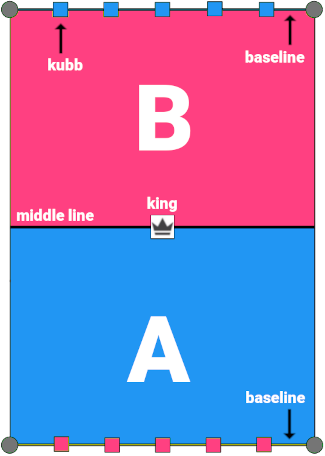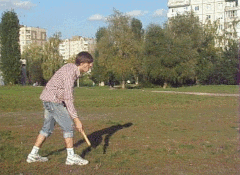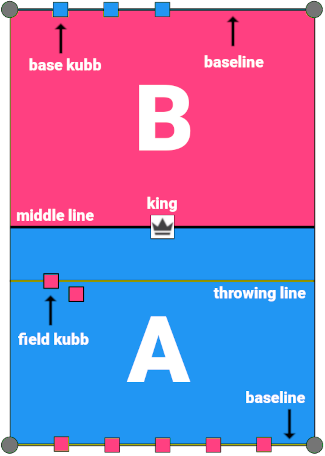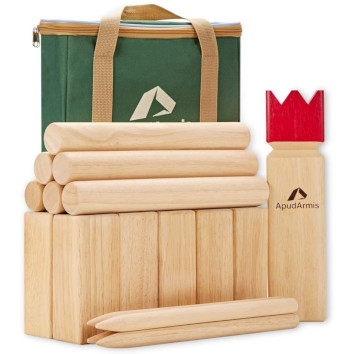Game Rules of Kubb
Setup and rules of the game
In a Nutshell
Equipment

- Four (or six) field marking pins
- Ten rectangular wooden blocks, called kubbs
- Six throwing batons
- One king
Setup
- The field marking pins are placed so that a rectangle is formed (see image)
- Five kubbs are placed on each of the baselines, equidistant from each other
- The king is placed upright in the center of the pitch
Gameplay
- Team A throws two batons from their baseline, at their opponent's baseline kubbs
- Kubbs that were successfully knocked over by team A are then thrown by team B onto team A's half of the pitch. These field kubbs are stood up again in the location where they landed
- Team B then throws four batons at team A's kubbs — first knocking over any standing field kubbs, and only then the base kubbs
- When a team is unable to knock over all field kubbs before their turn is over, the kubb closest to the centerline becomes the (throwing) baseline for the opposing team
- Play continues in this fashion, with team A and B now taking turns in throwing all six batons, until a team is able to knock over all kubbs on the other team's side. That team may now attempt to knock over the king
- The first team that topples the king, wins the game
- Fallen kubbs are thrown from the original baseline, as are attempts to knock over the king
- A team that accidentally knocks over the king during the game, immediately loses the game
More detailed
There are many so-called house rules, and they certainly have their value in bringing out various aspects of the game. However, the game rules that we will look at in detail here are the ones that are most commonly applied — those of the Kubb World Championship.
The kubb set and its official dimensions
A kubb set is generally made from rubber wood. This is because rubber wood is a hard wood that is shock-absorbent and does not easily chip or splinter. The 10 kubbs are rectangular blocks, 15cm (5.91inch) tall and 7cm (2.76inch) square. The king is a larger piece, 30cm (11.81inch) tall and 9cm (3.54inch) square — usually adorned with a crown design on the top. The 6 batons are 30cm (11.81inch) long and 4.4cm (1.73inch) in diameter. A kubb set also includes 6 field marking pins, 4 to designate the corners of the pitch, and 2 to mark the middle line (though the last 2 are often missing).
Game setup
Kubb is played on a rectangular pitch of 5 metres (5.47 yards) wide and 8 metres (8.75 yards) long. The pitch is delineated by four field marking pins — one at each corner. Two marking pins in the middle of the sidelines divide the pitch into two halves. Additional markers to demarcate the field's boundaries (such as chalk lines) are allowed, as long as they do not interfere with the course of the game. Five so-called base kubbs are placed on each of the short edges (baselines) of the rectangular pitch, equidistant from each other. The king is placed upright in the center of the pitch.
Course of the game
The game starts with team A throwing two batons from behind its baseline — both feet within the sidelines — at the kubbs on team B's baseline, with the aim of knocking them over. Each throw must be underhand, with the baton end pointing in the direction of flight. Rotating the baton horizontally (like a helicopter blade) is not allowed.
 The baton is thrown underhand, with the baton end pointing in the direction of the throw.
Play then changes hands. Kubbs that were knocked over by team A are picked up by Team B and thrown back onto Team A's half of the pitch. These kubbs are said to have joined the game, and are now called field kubbs — as opposed to the so-called base kubbs on the baselines. If a field kubb lands (invalidly) outside team A's half of the pitch, one re-throw is allowed. A second miss enables team A to position this field kubb anywhere on its half of the pitch, given that it's placed at least a baton’s length from the king and the pitch's corners. Only after all field kubbs have been thrown can invalidly thrown field kubbs be thrown again. Thus, it is possible to knock any invalid kubb back into play with subsequent field kubb throws.
The baton is thrown underhand, with the baton end pointing in the direction of the throw.
Play then changes hands. Kubbs that were knocked over by team A are picked up by Team B and thrown back onto Team A's half of the pitch. These kubbs are said to have joined the game, and are now called field kubbs — as opposed to the so-called base kubbs on the baselines. If a field kubb lands (invalidly) outside team A's half of the pitch, one re-throw is allowed. A second miss enables team A to position this field kubb anywhere on its half of the pitch, given that it's placed at least a baton’s length from the king and the pitch's corners. Only after all field kubbs have been thrown can invalidly thrown field kubbs be thrown again. Thus, it is possible to knock any invalid kubb back into play with subsequent field kubb throws.
The field kubbs that were successfully thrown within team A's half of te pitch are stood up again on the exact position where they landed, in the direction of team A's choice. A field kubb that has landed on the pitch's boundary must be raised so that at least half the kubb's base is within the pitch area.
Team B now throws four batons at Team A's kubbs. Before team B can target base kubbs however, they must first knock over all standing field kubbs within team A's half of the pitch. If a base kubb is knocked over before all field kubbs have been overturned, it must be stood up again — it remains a base kubb. A kubb which has been correctly overturned in the course of a team's turn, remains overturned — even though it may later be raised accidentally in the course of that turn.

Play continues in this fashion, with team A and B now taking turns in throwing all six batons, until a team manages to knock over all the field and base kubbs in their opponent's half of the pitch. If that team still has batons left to throw, they may attempt to knock over the king. A team that successfully topples the king, wins the the game!
Important: The king may only be overturned when all kubbs on the opponent's side are knocked over. If it is overturned earlier — either by baton or kubb — the team responsible loses the game.
Game Variants
- Instead of throwing two batons on the first turn, four batons on the second turn and six batons on subsequent turns (2-4-6), the teams can agree to just throw all six batons each turn from the start.
- To make the game more accessible to small children you can reduce the size of the playing field, or allow them to throw from the middle line.
- To shorten the duration of the game, you can simply reduce the number of base kubbs. Alternatively, you can take base kubbs — or field kubbs — that have been knocked over out of the game.
- Another variant relates to the placement of the field kubbs. When throwing field kubbs into the opponent's half of the pitch, you can try to hit field kubbs that have already been thrown in. If this succeeds, these field kubbs are stacked one on top of the other, or placed next to each other in a row.
- To make the end of the game even more exciting, you can include the requirement to hit the king with your back to the playing field, while throwing the baton through the legs. Another possibility is that the king must be knocked over by right-handers with the left hand and vice versa.
- ...
Where to Buy?

If you're looking to buy a Kubb set, we recommend the one featured on Amazon.
This set has the official dimensions used in tournaments and championships worldwide. Also — most importantly — it’s made from shock-absorbent rubberwood, a durable material that resists chipping and splintering, making it ideal for repeated outdoor play.
Heads up: the following link is an affiliate link. If you take action (i.e. make a purchase) after clicking it, we'll earn some coffee money. You do not pay a higher price.
view on amazon.com



